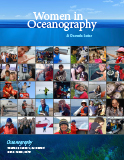Article Abstract
MPOWIR (Mentoring Physical Oceanography Women to Increase Retention) is a US community-initiated and community-led mentoring program aimed at improving the retention of women physical oceanographers in academic and/or research positions. This article describes the MPOWIR program elements designed by the US physical oceanography community, quantifies the participation in these programs, describes MPOWIR's impact to date, and outlines future directions. An examination of surveys to date indicates that MPOWIR, several years after its implementation, is having a positive impact on the retention of junior women in physical oceanography, primarily by giving them a broad professional network and focused mentoring.

